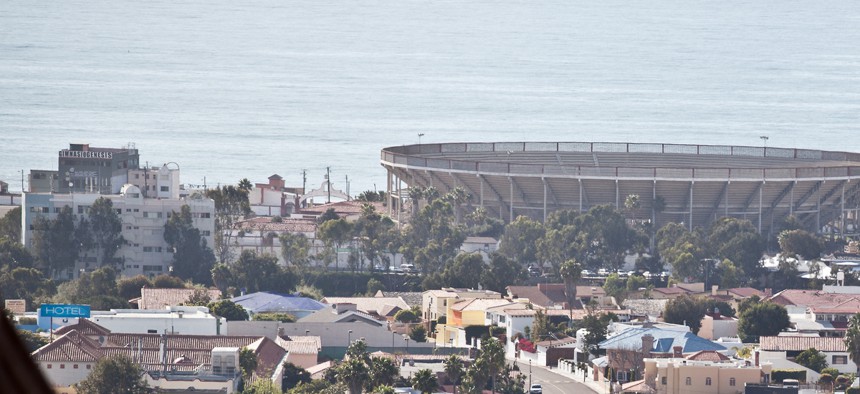
Customs and Border Protection file photo
Is America Heading Toward a Border Crisis?
Mexican immigration-enforcement might keep many migrants from U.S. border this summer, but kids are still fleeing Central America.
Central American kids are not coming across the U.S. southern border at the record rate they were a year ago, but the crisis is not over.
So far this year—a point when the uptick was just beginning last year—the number of migrants coming across America's border has stabilized. While many of the children who came last summer are still here, meandering through the U.S. court system, the rate of new flows has dropped significantly. At this time last year, 21,403 unaccompanied Central American kids had crossed into the United States and by the end of the year, nearly 70,000 had come, putting a strain on U.S. Border Patrol and the Health and Human Services Department, which was required by law to place Central American children in temporary housing so they could be screened for refugee status. This year, the numbers are down 42 percent. Just 12,509 children have been apprehended.
But border crossings from Mexico to the United States don't tell the whole story.
While Central Americans aren't making it to the U.S. at the same rate, the push factors that drove the crisis last summer show no sign of abating. Gang violence and murder rates remain high in Central America, especially in El Salvador and Honduras. And the family ties and economic opportunities that have pulled migrants to the U.S. for years are still magnets.
What has significantly shifted is Mexico's investment to secure its own southern borders with Belize and Guatemala. What were in previous years more-porous crossing sites have now been reinforced with stringent security.
Christopher Wilson, a senior associate at the Mexico Institute of the Woodrow Wilson International Center for Scholars, said on a recent trip he observed a far stronger presence of Mexican authorities and an increase in patrols along swaths of land that once were un-patrolled. Mexico also is in the process of erecting four new checkpoints further north in the interior to combat drug and human smuggling. And the Mexican government has cracked down on the number of migrants traveling on La Bestia—a dangerous network of cargo trains that immigrants have hopped aboard for years to travel through Mexico.
While the number of border crossings in the United States is down, the number of apprehensions in Mexico is rising. According to the National Migration Institute's numbers, 120,000 Central Americans were detained in 2014. This year, there has already been a 200 percent increase over that same period of time last year. From January through February 2014, Mexico's immigration branch recorded that it had caught 13,821 Central Americans. One year later, that number had nearly trippled as Mexican authorities stepped up patrols and detained 40,467 Central Americans.
"The underlying drivers have still not been addressed yet," says Mark Rosenblum, the deputy director of the U.S. Immigration Policy Program at the Migration Policy Institute. "It is likely that people will find some other ways to come."
Until root causes of violence and gang intimidation are addressed, advocates worry that cracking down on enforcement along Mexico's Southern border could ultimately mean fewer escape options for kids living in dangerous situations in Central America.
"Are you sealing these kids into a burning building? That is a profoundly serious concern," says Marshall Fitz, the vice president of immigration policy at the Center for American Progress.
A U.N. Refugee Agency report last year found that more than 70 percent of children coming from a country such as El Salvador were fleeing violence and that many were eligible for some kind of refugee status. In the U.S., children from Central America cannot be returned to their home countries immediately. They automatically are held for a longer period and screened for special status. Advocates have doubts that the children are given the same intensive screening process in Mexico.
"The Mexican government and other countries in the region are actively intercepting people on their way to the U.S. and primarily returning them without screening them for protection—and in some ways, to me, that is the biggest crisis of all," says Wendy Young, the executive director of Kids in Need of Defense, a group that provides legal counsel to unaccompanied minors. "I think people were obviously alarmed by the pictures of what they saw happening at the border last summer, but taking an out-of-sight, out-of-mind approach and turning people around before they encounter our border is still returning people to very risky situations where their lives may be at risk."
Young says that the Mexican government is essentially "doing our dirty work for us."
For the Obama administration, preventing another migrant crisis at the U.S.'s doorstep is essential, politically. After announcing an executive order shielding millions of immigrants in the country already from deportation, Obama would face the brunt of the blame for any uptick in border crossings this summer. His 2012 decision to halt the deportation of "Dreamers" was often cited as a reason migrants were flooding into the United States last summer. To dispel the rumors, the U.S. government executed an aggressive public-relations campaign to educate parents and children in Central America about the dangers of the journey. They also fought hard against the human smugglers' claims to families that "permisos" were waiting for children who made it across the Rio Grande.
But even with a decrease in border crossings, advocates and government officials say that the U.S. cannot be lulled into thinking that the crisis is over. Nor, can we expect that Mexico can hold the line alone.
"Although we have seen a significant decline in unaccompanied children and families crossing the border compared to the previous year, we remain vigilant and continue to work with our federal counterparts to ensure we are prepared for any potential scenario," says Michael Friel, a spokesman for the Border Patrol.







